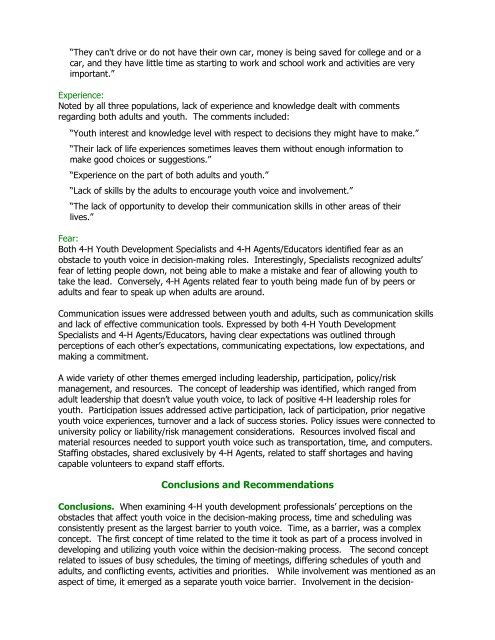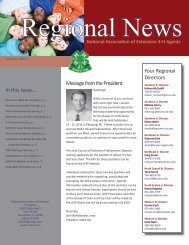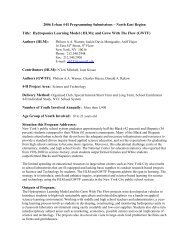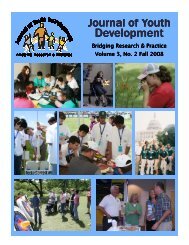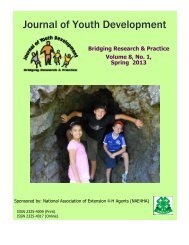Winter 2008 - Vol. 3 No. 3 - National Association of Extension 4-H ...
Winter 2008 - Vol. 3 No. 3 - National Association of Extension 4-H ...
Winter 2008 - Vol. 3 No. 3 - National Association of Extension 4-H ...
- No tags were found...
Create successful ePaper yourself
Turn your PDF publications into a flip-book with our unique Google optimized e-Paper software.
“They can't drive or do not have their own car, money is being saved for college and or acar, and they have little time as starting to work and school work and activities are veryimportant.”Experience:<strong>No</strong>ted by all three populations, lack <strong>of</strong> experience and knowledge dealt with commentsregarding both adults and youth. The comments included:“Youth interest and knowledge level with respect to decisions they might have to make.”“Their lack <strong>of</strong> life experiences sometimes leaves them without enough information tomake good choices or suggestions.”“Experience on the part <strong>of</strong> both adults and youth.”“Lack <strong>of</strong> skills by the adults to encourage youth voice and involvement.”“The lack <strong>of</strong> opportunity to develop their communication skills in other areas <strong>of</strong> theirlives.”Fear:Both 4-H Youth Development Specialists and 4-H Agents/Educators identified fear as anobstacle to youth voice in decision-making roles. Interestingly, Specialists recognized adults’fear <strong>of</strong> letting people down, not being able to make a mistake and fear <strong>of</strong> allowing youth totake the lead. Conversely, 4-H Agents related fear to youth being made fun <strong>of</strong> by peers oradults and fear to speak up when adults are around.Communication issues were addressed between youth and adults, such as communication skillsand lack <strong>of</strong> effective communication tools. Expressed by both 4-H Youth DevelopmentSpecialists and 4-H Agents/Educators, having clear expectations was outlined throughperceptions <strong>of</strong> each other’s expectations, communicating expectations, low expectations, andmaking a commitment.A wide variety <strong>of</strong> other themes emerged including leadership, participation, policy/riskmanagement, and resources. The concept <strong>of</strong> leadership was identified, which ranged fromadult leadership that doesn’t value youth voice, to lack <strong>of</strong> positive 4-H leadership roles foryouth. Participation issues addressed active participation, lack <strong>of</strong> participation, prior negativeyouth voice experiences, turnover and a lack <strong>of</strong> success stories. Policy issues were connected touniversity policy or liability/risk management considerations. Resources involved fiscal andmaterial resources needed to support youth voice such as transportation, time, and computers.Staffing obstacles, shared exclusively by 4-H Agents, related to staff shortages and havingcapable volunteers to expand staff efforts.Conclusions and RecommendationsConclusions. When examining 4-H youth development pr<strong>of</strong>essionals’ perceptions on theobstacles that affect youth voice in the decision-making process, time and scheduling wasconsistently present as the largest barrier to youth voice. Time, as a barrier, was a complexconcept. The first concept <strong>of</strong> time related to the time it took as part <strong>of</strong> a process involved indeveloping and utilizing youth voice within the decision-making process. The second conceptrelated to issues <strong>of</strong> busy schedules, the timing <strong>of</strong> meetings, differing schedules <strong>of</strong> youth andadults, and conflicting events, activities and priorities. While involvement was mentioned as anaspect <strong>of</strong> time, it emerged as a separate youth voice barrier. Involvement in the decision-


